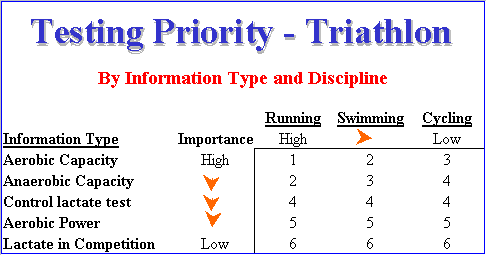|
|
Testing Priorities
There are many considerations for a testing program of a triathlete. Three
important factors are:
- A triathlon contains three events, swimming, cycling and running.
- A sport specific test is needed in order to deduce training
information. For example, a test for cycling will not work for running.
- It is difficult to conduct a complete specific
test for each discipline and not disrupt training.
Thus it is necessary for the coach or athlete to set up priorities for
testing. Certain types of information are more important than others and if
you have to sacrifice elements of a testing program the following criteria
should be used:
Greatest need by discipline -
- Running should be the first priority. We have noticed that running training has the most risks
for making mistakes and the consequences of these mistakes are the most severe and long lasting.
Thus, more systematic testing time and resources should be allocated to running than to the
other two disciplines.
- Swimming should receive the second emphasis for testing. Errors in
swim training are less frequent and the consequences less severe. The athlete
can recover more easily from the negative consequences of swimming mistakes.
- Testing for cycling is the third priority. This
doesn't mean that cycling is less important or that training for cycling
should not be as serious. It is obviously very important. This just
means that more serious mistakes in training are made in running and in
swimming. We don't recommend that a triathlete not test in cycling, just
that the priority is not as great.
Greatest need by type of information -
- First priority for information is aerobic capacity. Since this will be
hard to get with simple lactate tests, the testing protocols will measure an
aerobic capacity related variable such as the speed at 4 mmol/l during an
effort of least 4 minutes.
- Second priority for information is anaerobic capacity. This will be
approximated with an anaerobic capacity related variable such as maximal
lactate concentration after a short all-out effort. (not more than 2 minutes)
- The next priority is control tests or lactate tests of training sets.
- The fourth priority is aerobic power or what is known as the maximum lactate steady state. This
is often referred to as the lactate threshold or anaerobic threshold.
- The last priority for a triathlete is lactate
in competition.
The table below represents a combination of the need by discipline and need
by type of information. Use it as a guide to set testing priorities. The
highest priority in this table is represented by the number 1 which is for a
test of aerobic capacity (or an aerobic capacity related test) of running. The
more time or more one wants to invest in testing, the more the coach or
athlete will be guided by the priority scheme. For the recreational athlete we
recommend that they do 1 and 2 and possibly the aerobic capacity test for
cycling. For serious triathletes we recommend that the athlete do priorities
1-4. Only for elite athletes do we advise to proceed to priority 6. But even for
for these athletes only some the test periods will contain all the tests.

|
|





